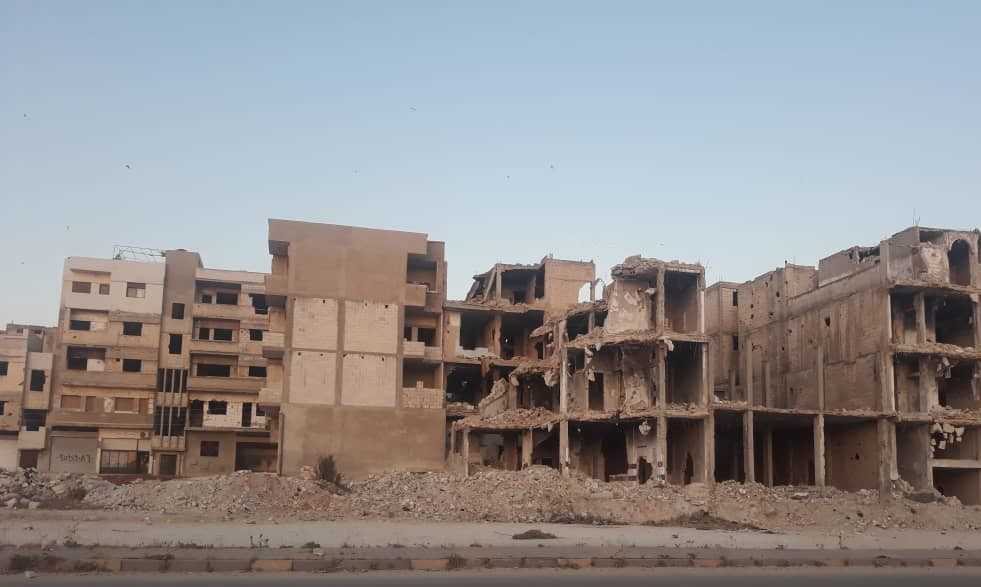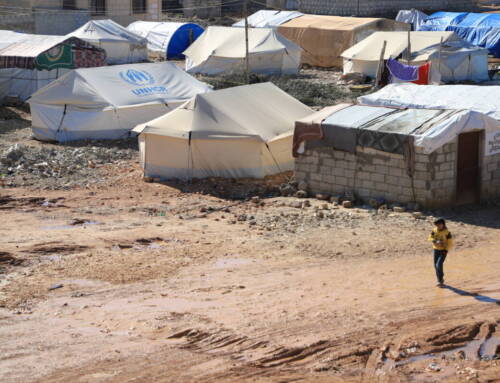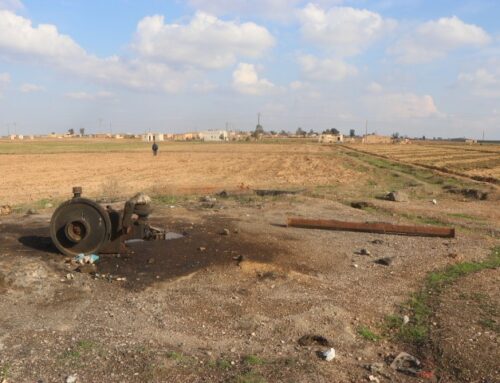100 percent increase: How raising cement prices impact Syrians
In mid-May, Damascus increased the price of cement for the fourth time in two years. As costs go up, repairing war-damaged homes becomes difficult or impossible.
1 June 2022
AMMAN — Abu Raed woke early to the sound of his phone ringing one morning two weeks ago. The contractor repairing his house was on the other end of the line. He gave Abu Raed two options: “increase the agreed-upon amount for the repair, after the cement price hike, or stop the work.”
On May 11, the Syrian Ministry of Internal Trade and Consumer Protection issued a decision to raise the price of cement by up to 100 percent. The price of one ton of 32.5-grade portland cement was raised from SYP 216,000 to SYP 397,760 (from $54 to $100, according to the parallel market exchange rate of SYP 3,955 to the dollar).
Under the ruling, the price of one ton of pozzolanic cement went up to SYP 301,670 ($76), and oil-well cement rose to SYP 458,450 ($116). Sulfate-resistant cement increased to SYP 436,860 ($110), and 42.5 grade portland cement to SYP 413,490 ($105).
As the price of cement goes up, so does the cost of repairing or rebuilding houses damaged or destroyed by shelling or airstrikes. The increased costs seep into the construction and housing markets, but ultimately hit consumers—those often already suffering under Syria’s economic collapse—the hardest.
Postponed repairs
After spending four years displaced in Homs city’s western al-Waer district, Abu Raed returned with his wife and three children to the city’s northern al-Qarabis district in February 2021. Al-Qarabis was among the Homs districts that were largely destroyed by extensive regime bombardment during the Siege of Homs from 2012-2014. He hoped to settle there, in the neighborhood where he grew up, “among relatives and neighbors, after years of separation.”
After returning, Abu Raed, 45, started to repair his house. Its roof and walls were destroyed, in addition to problems with the electricity and water lines. He agreed with a contractor to begin the repairs, “starting with the fundamental damages, and to patch up the collapsed parts of the house to make it inhabitable,” he told Syria Direct.
By the end of 2021, Abu Raed had spent SYP 3 million ($760) on repairs. Throughout the year, the price of cement was raised three times: on April 1, April 18 and September 22.
After the latest price hike, “I’m no longer able to complete my house’s reconstruction,” Abu Raed said. He works at a shop in Homs selling appliances for less than SYP 700,000 ($177) a month. He spends SYP 100,000 ($25) of that to rent a residence near the house he is repairing, and the rest of the money is barely enough to cover basic monthly expenses.
Abu Raed has lost hope of living in his house again any time soon. Beyond the increased price of cement, the prices of other building materials and construction workers’ wages are also going up. All told, he expects the repairs to cost more than SYP 10 million ($2,528), rather than the SYP 7 million ($1,770) he expected to pay when starting the process.
Between March 2011 and April 2021, the Damascus government increased the price of cement 30-fold and the price of iron used in construction 100-fold, reaching SYP 7 million ($1,770) per ton.
Who pays for price hikes?
Consumers are hardest-hit by price increases in Syria, but “my situation is no better than the customers,” said Abu Jaber, the contractor responsible for repairing Abu Raed’s house. He told Syria Direct the cost of a 50-kilogram bag of cement jumped from SYP 7,000 ($1.75) at the beginning of 2021 to SYP 37,000 ($9.30) today. With the price of iron also up multiple times its price, he wondered: “Who covers the difference?”
At a time when “people can barely afford to eat and drink,” the construction sector in Syria has retreated, Abu Jaber said. “Housing projects have stopped completely,” he said. His work in home repairs and essential maintenance has also declined.
The Ministry of Trade’s recent decision to raise cement prices was preceded by cement companies reducing the quantities distributed to contractors, resulting in market shortages. For example, the state-owned Omran Cement Company reduced the quantities on the market before the latest price hike decision was issued, increasing the price of a 50-kg bag to SYP 50,000 ($12.70) and impacting the work of contractors.
Abu Jaber usually relies on brick factories to obtain cement, as the factories offer quantities of their “official” share on the black market. There, it is sold at prices higher than the government pricing, exploiting “the demand for cement and its lack of availability in official outlets.”
Although anyone with a license can access cement alongside the factories and companies belonging to the General Organization for Cement—a state-owned set of companies manufacturing cement and other construction materials—there is a “long waiting period to get receive the allowances,” economist Muhammad al-Jalali told pro-government Syrian newspaper Al-Watan on May 17. This drives people to buy cement from the black market.
Economic analyst Younis al-Karim explained the difficulty of obtaining cement as the result of “consumption by the military sector and senior government cement officials.” He also cited the prioritization of “business owners who are war profiteers and warlords,” referring to projects such as Basilia City and Marota City. The latter is being carried out by the Damascus Governorate and Cham Holding Company.
The local market need for cement is about 20 million tons per year, while public and private sector factories produce only about four million tons, according to a statement by Minister of Industry Ziyad Sabbagh late last year.
While sources affiliated with or loyal to Damascus have downplayed the impact of increasing the price of cement on property costs, since they were elevated before the recent decision, building contractors told Syria Direct that the housing market is “frozen” and suffering what they described as “unprecedented stagnation.”
Khaled al-Turkawi, a Syrian economist and researcher at the Turkey-based Jusoor Center for Studies, said the increase in the prices of cement and iron in particular “is accompanied by a state of stagnation in the real estate market.” He noted that some construction companies deliberately “postpone their projects in conjunction with leaks that prices will be raised, in order to profit from the new price difference.”
From one crisis to another
After life became difficult in Lebanon, which has been suffering an economic crisis since 2019, Abu Saad, a 39-year-old father of two, decided to return to Syria at the beginning of 2021 after eight years as a refugee. He found that his house in the Damascus suburbs “needs to be rebuilt, due to the severity of the destruction.” His house is located in an area that was controlled by the Syrian opposition before the regime retook control of it in the spring of 2018.
Abu Saad was shocked at the scale of destruction to his house and the poor services in his city. He described his return as someone fleeing from one crisis to another. He is not able to pay the costs of repairing his house, which “may exceed SYP 30 million [$7,585],” according to estimates a contractor gave him, “which is an impossible amount” at a time when the average income is SYP 92,000 ($23).
The contractor suggested Abu Saad “build a small room and bathroom” instead of repairing the whole house, which was done “at a cost of SYP 2.5 million” ($632 at the current exchange rate). Construction was limited to “the roof, columns and walls,” he said.
Economist Muhammad al-Jalali, speaking to Al-Watan in early May, estimated the cost of building and cladding one square meter at about SYP 1 million ($253). He pointed out that the high costs of construction and cladding make buying real estate cheaper than building, as the sale price of one square meter is less than SYP 900,000 ($127).
For his part, contractor Abu Jaber estimated the cost of building one square meter, without cladding, after the recent increase in cement and iron prices, at about SYP 750,000 ($190). Last year, the cost ranged from SYP 200,000 to SYP 250,000 ($50-$63), according to estimates by Ihsan Qanaya, the President of the Construction Workers Union.
Like Abu Saad, Syrian refugees returning to their country are shocked by the reality that the cost to repair their damaged homes are beyond their means. A 2021 report from Human Rights Watch pointed to severe economic difficulties faced by most returnees to Syria, as they found their houses completely or partially destroyed and could not afford repairs.
‘I lost my dream and my money’
In 2000, Muhammad al-Homsi decided to subscribe for an apartment through a housing association belonging to the Directorate of Endowments in Homs city, in the hopes of realizing his dream of owning his own apartment, he told Syria Direct.
Under apartment subscription plans, an individual pays a deposit and enters into a monthly payment agreement. Once half of the price is paid, they receive the apartment. Such arrangements are available to anyone, but most often used by people with limited incomes.
Al-Homsi, who was working at a clothing store with his father and uncles at the time, committed to a monthly installment plan of SYP 1,500 ($30 according to the exchange rate at the time), an amount that today would be equivalent to $0.38. By the end of 2010, the total sum paid to the association as a down payment and monthly installments was SYP 450,000 ($9,000 at the time).
The housing association had informed al-Homsi of “the location of the apartment, and told me it was on the seventh floor of the building,” but then “went on forced leave due to the revolution breaking out in 2011,” he said.
After the regime regained control of all of Homs city in 2018, the association resumed its work, but demanded al-Homsi pay SYP 30 million ($7,585) “to make up for the currency difference, production costs, and prices of construction materials,” he said. This forced him to “sell my share for SYP 10 million [$2,528]” after he was unable to secure the required amount of money, in the hopes of “minimizing my loss.”
Al-Homsi, 48, is one of hundreds of people who subscribed with housing associations and have been forced to sell their shares to expatriates, contractors and well-off people after losing hope of obtaining their apartments. They are unable to pay the monthly installments of hundreds of thousands of pounds, while the ceiling of their salaries is less than SYP 100,000 ($25).
By selling his share, al-Homsi recouped less than 30 percent of the amount he paid, according to the dollar exchange rate compared between the two time periods. He feels that he and people like him have paid the bill for the war and the resulting rise in the prices of materials and deterioration in the value of the national currency.
“I lost my dream and my money,” he said.
This report was originally published in Arabic and translated into English by Mateo Nelson.







